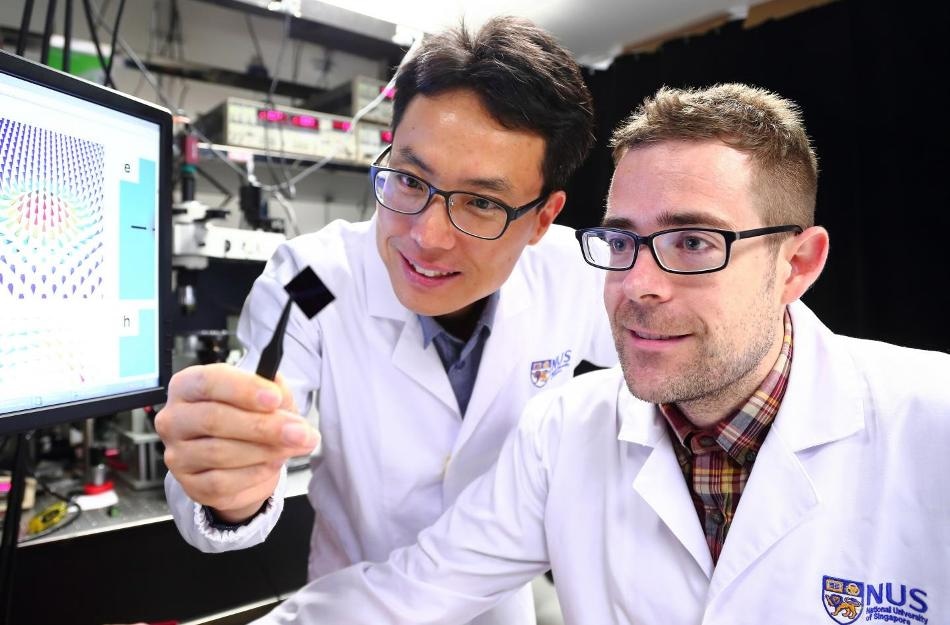Apr 11 2017
 Associate Professor Yang Hyunsoo (left) and Dr Shawn Pollard (right), who are from the Department of Electrical and Computer Engineering at the NUS Faculty of Engineering, are key members of a research team that invented a novel ultra-thin multilayer film which could harness the properties of skyrmions as information carriers for storing and processing data on magnetic media. CREDIT: Siew Shawn Yohanes.
Associate Professor Yang Hyunsoo (left) and Dr Shawn Pollard (right), who are from the Department of Electrical and Computer Engineering at the NUS Faculty of Engineering, are key members of a research team that invented a novel ultra-thin multilayer film which could harness the properties of skyrmions as information carriers for storing and processing data on magnetic media. CREDIT: Siew Shawn Yohanes.
An innovative ultra-thin multilayer film has been developed by a research team. The team is headed by Associate Professor Yang Hyunsoo at the Department of Electrical and Computer Engineering of the Faculty of Engineering at the National University of Singapore (NUS). The novel film has the ability to tap the characteristics of tiny magnetic whirls (i.e. skyrmions) as information carriers to store and process data on magnetic media.
The nano-sized thin film was created by working in cooperation with scientists from Brookhaven National Laboratory, Stony Brook University and Louisiana State University. It is believed to be crucial in designing data storage devices that consume less power, but work fast when compared to prevalent memory technologies. The outcome of the research has been published on 10 March 2017 in Nature Communications, a prestigious scientific journal.
Tiny magnetic whirls with huge potential as information carriers
In the digital transformation era, there has been an ever-rising demand for enhancing hard drive technology, for storing vast amounts of data, and for better processing. Skyrmions — swirling magnetic textures just a few nanometres in size — were discovered in 2009. Since then, there has been considerable research conducted on using skyrmions as prospective information carriers in next-generation logic and data storage devices.
Skyrmions are known to occur in layered systems, in which a heavy metal is positioned under a ferromagnetic material. The synergy between the disparate materials leads to an interfacial symmetry breaking interaction called as the Dzyaloshinskii-Moriya Interaction (DMI). This assists in stabilizing a skyrmion. The skyrmion’s stability is affected due to the absence of an out-of-plane magnetic field. Moreover, the nano-sized materials are hard to image due to their tiny size.
In order to overcome these flaws, the research team aimed to develop stable magnetic skyrmions at room temperature without necessitating a biasing magnetic field.
Unique material for data storage
The researchers from NUS, including Dr Shawn Pollard and Ms Yu Jiawei from the NUS Department of Electrical and Computer Engineering, discovered that in multilayer films made of palladium and cobalt, a large DMI — adequately large to stabilize skyrmion spin textures — could be maintained.
For imaging the magnetic structure of the films, the NUS research team worked in cooperation with Brookhaven National Laboratory in the United States to use Lorentz transmission electron microscopy (L-TEM) with the potential to image magnetic structures with a size of less than 10 nm. However, to date, L-TEM has not been used to investigate skyrmions in multilayer geometries as it was estimated to emit zero signal. When the experiments were performed, the research team discovered that a clear contrast, consistent with that which was anticipated for skyrmions (with a size of less than 100 nm), can be obtained by tilting the films with reference to the electron beam.
It has long been assumed that there is no DMI in a symmetric structure like the one present in our work, hence, there will be no skyrmion. It is really unexpected for us to find both large DMI and skyrmions in the multilayer film we engineered. What's more, these nanoscale skyrmions persisted even after the removal of an external biasing magnetic field, which are the first of their kind.
Dr Shawn Pollard
This experiment not only demonstrates the usefulness of L-TEM in studying these systems, but also opens up a completely new material in which skyrmions can be created. Without the need for a biasing field, the design and implementation of skyrmion based devices are significantly simplified. The small size of the skyrmions, combined with the incredible stability generated here, could be potentially useful for the design of next-generation spintronic devices that are energy efficient and can outperform current memory technologies.
Associate Professor Yang Hyunsoo
Next step
At present, Associate Professor Yang and his colleagues are working to find the way in which nanoscale skyrmions interact with electrical currents and with one another. They also want to promote the expansion of skyrmion-based electronics.